Carestream Health KODAK1500H KODAK 1500 Intraoral Camera - Handpiece User Manual 1500 Camera Safety Regulatory Guide
Carestream Health, Inc. KODAK 1500 Intraoral Camera - Handpiece 1500 Camera Safety Regulatory Guide
User Manual

8G8224-01
KODAK 1500 Intraoral Camera
Safety and Regulatory Guide
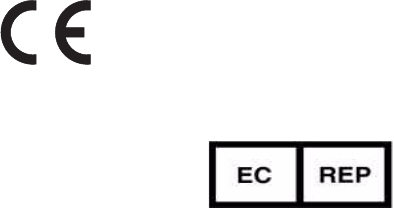
Notice
©Carestream Health, Inc., 2009. The information in this document is subject to
change. Neither Carestream Health nor any of its subsidiaries shall be liable for errors
contained herein or for incidental damages in conjunction with the furnishing,
performance, or use of this material. No part of this publication may be reproduced
with the permission of Carestream Health, Inc.
Carestream is a trademark of Carestream Health, Inc.
The Kodak trademark and trade dress are used under license from Kodak.
All other trademarks and registered trademarks are the property of their respective
holders.
US Federal law restricts this device to sale by or on the order of a dentist.
The Kodak 1500 intraoral camera is also marketed and sold as the STV Pro +
intraoral camera.
Manual Name: KODAK 1500 Intraoral Camera Safety and Regulatory Guide
Part Number: 8G8224
Revision Number: 01
Print Date: August 2009
Authorized Representative:
Handpiece:
FCC ID: U72KODAK1500H
IC: 7027A-KODAK1500
Docking Station
FCC ID: U72KODAK1500
IC: 7027A-KODAK 1500

KODAK 1500 Intraoral Camera Safety and Regulatory Guide (8G8224) 1
Safety and Regulatory
Information
Indications for Use
The KODAK 1500 intraoral camera is designed for use by health
professionals in viewing and capturing intraoral or extraoral color images
for the purpose of:
•Enabling practitioners to view and magnify all regions of the oral
cavity to assess overall dental health.
•Assisting communications with the patient by providing a view of
treatment areas before and after a procedure.
•Providing images for documentation in patient records.
There are two configurations for the camera: wired and wireless. The
wired camera is composed of a camera, a docking station, and
accessories. The wireless camera is composed of an additional charge
station and accessories.
Regulatory Information
The KODAK 1500 intraoral camera complies with the following
standards:
•93/42/EEC European directive for medical devices including
EN 60601-1-2 and collaterals
•Electrical Safety and Electromagnetic Compatibility standards
(IEC) (CEM)
•Guidance and Manufacturer’s Declaration - Electromagnetic
Emissions

2
Electromagnetic Compatibility Precautions
Medical electrical equipment requires special precautions regarding
electromagnetic compatibility (EMC). Medical equipment must be
installed and put into service according to the EMC information provided
in this documentation.
Other equipment can interfere with communications with the intraoral
camera, even if the equipment complies with CISPR emissions
requirements.
Guidance and Manufacturer’s Declarations
Guidance and Manufacturer’s Declaration - Electromagnetic
Emissions
The KODAK 1500 intraoral camera is intended for use in the electromagnetic
environment specified below. The customer or user of the intraoral camera should
assure that it is used in such an environment.
Emissions Test Compliance Electromagnetic Environment - Guidance
RF Emissions
CISPR 11 Group 1
The intraoral camera uses RF energy only for
its internal function. Therefore, its RF
emissions are low and are not likely to cause
any interference in nearby electronic
equipment.
RF Emissions
CISPR 11 Class B
The intraoral camera is suitable for use in all
establishments including domestic
establishments and those directly connected
to the public low-voltage power supply
network that supplies buildings used for
domestic purposes.
Harmonics Emissions
IEC 61000-3-2 Class A
Voltage
Fluctuations/
Flicker Emissions
IEC 61000-3-3
Complies
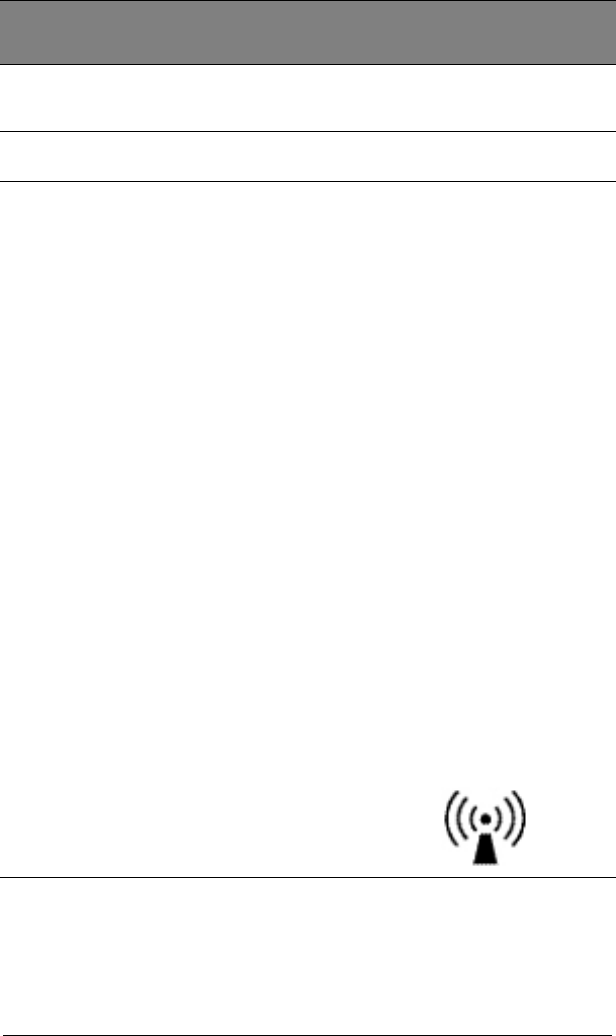
KODAK 1500 Intraoral Camera Safety and Regulatory Guide (8G8224) 3
Guidance and Manufacturer’s Declaration - Electromagnetic
Immunity
The KODAK 1500 intraoral camera is intended for use in the electromagnetic
environment specified below. The customer or the user of the intraoral camera should
assure that it is used in such an environment.
Immunity Test IEC 60601
Test Level Compliance
Level Electromagnetic Environment -
Guidance
Conducted RF
IEC 61000-4-6
Radiated RF
IEC 61000-4-3
3 Vrms
150 kHz to 80
MHz
3 V/M
80 MHz to
2.5GHz
3 Vrms
3 V/M
Portable and mobile RF
communications equipment should
be used no closer to any part of the
Kodak 1500 Intraoral camera,
including cables, than the
recommended separation distance
calculated from the equation
applicable to the frequency of the
transmitter.
Recommended separation distance
d=1.17 ÖP
d = 1.17 ÖP 80 MHz to 800 MHz
d = 2.33 ÖP 800MHz to 2.5GHz
where P is the maximum output
rating of the transmitter in watts (W)
according to the transmitter
manufacture and is the
recommended separation distance
in meters (m).
Field strengths from fixed RF
transmitters, as determined by an
electromagnetic site surveya,
should be less than the compliance
level in each frequency rangeb.
Interference may occur in the
vicinity of equipment marked with
the following symbol:

4
Note 1: At 80 MHz and 800 MHz, the higher frequency range applies.
Note 2: These guidelines may not apply in all situations. Electromagnetic propagation
is affected by absorption and reflection from structures, objects and people.
a Field strengths from fixed transmitters, such as base station for radio
(cellular/cordless) telephones and land mobile radios, amateur radio, AM and FM
radio broadcasts, and TV broadcasts cannot be predicted theoretically with
accuracy. To assess the electromagnetic environment due to fixed RF transmitters, an
electromagnetic site survey should be considered. If the measured field strength in
the location in which the intraoral camera system is used exceeds the applicable RF
compliance level above, the intraoral camera should be observed to verify normal
operation. If abnormal performance is observed, additional measures may be
necessary, such as reorienting or relocating the Kodak 1500 intraoral camera.
b Over the frequency range 150 kHz to 80 MHz, field strengths should be less than
3 V/M.
Guidance and Manufacturer’s Declaration - Electromagnetic
Immunity (Continued)
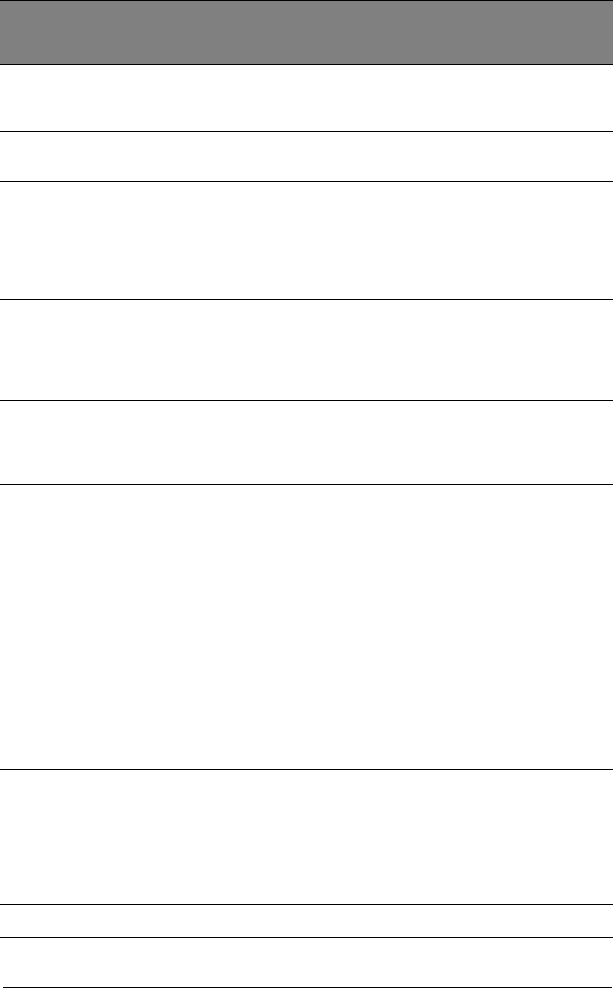
KODAK 1500 Intraoral Camera Safety and Regulatory Guide (8G8224) 5
EMC Standards Information
Electromagnetic Immunity for Equipment and Systems Fully
Compliant with IEC 60601-2:2001+A1:2004
The KODAK 1500 intraoral camera is intended for use in the electromagnetic
environment specified below. The customer or the user of the intraoral camera
should assure that it is used in such an environment.
Immunity Test IEC 60601
Test Level Compliance
Level Electromagnetic
Environment- Guidance
Electrostatic
Discharge (ESD)
IEC 61000-4-2
+/- 6 kV contact
+/- 8 kV air
+/- 6 kV contact
+/- 8 kV air
Floors should be wood,
concrete, or ceramic tile.
If floors are covered with
synthetic material, the
relative humidity should
be at least 30%.
Electrical fast
transient/burst
IEC 61000-4-4
+/- 2 kV for power
supply lines
+/- 1 kV for
input/output lines
+/- 2 kV for power
supply lines
+/- 1 kV for
input/output lines
Mains power quality
should be that of a
typical commercial or
clinical environment.
Surge
IEC 61000-4-5
+/- 1 kV line to line
+/- 2 kV line to
earth
+/- 1 kV line to line
+/- 2 kV line to
earth
Mains power quality
should be that of a
typical commercial or
hospital environment
Voltage dips,
short
interruptions and
voltage variations
on power supply
lines
IEC 61000-4-11
<5% UT (>95%
dip in UT) for 0.5
cycle
40% UT(60% dip
in UT) for 5 cycles
70% UT (30% dip
in UT) for25
cycles
<5% UT (>95%
dip in UT) for 5
sec.
<5% UT (>95%
dip in UT) for 0.5
cycle
40% UT (60% dip
in UT) for 5 cycles
70%UT (30% dip
in UT) for25
cycles
<5% UT (>95%
dip in UT) for 5
sec.
Mains power quality
should be that of a
typical commercial or
hospital environment.
Note: Most components
in the intraoral camera
are powered from an
uninterruptible power
supply.
IEC 61000-4-11 is
applicable only to the
intraoral camera
Power frequency
(50/60Hz)
magnetic field
IEC 61000-4-8
3 A/m 3 A/m
Power frequency
magnetic fields should
be at levels
characteristic of a typical
location in a typical
commercial or hospital
environment.
Note: UT is the a.c. prior to application of the test level.
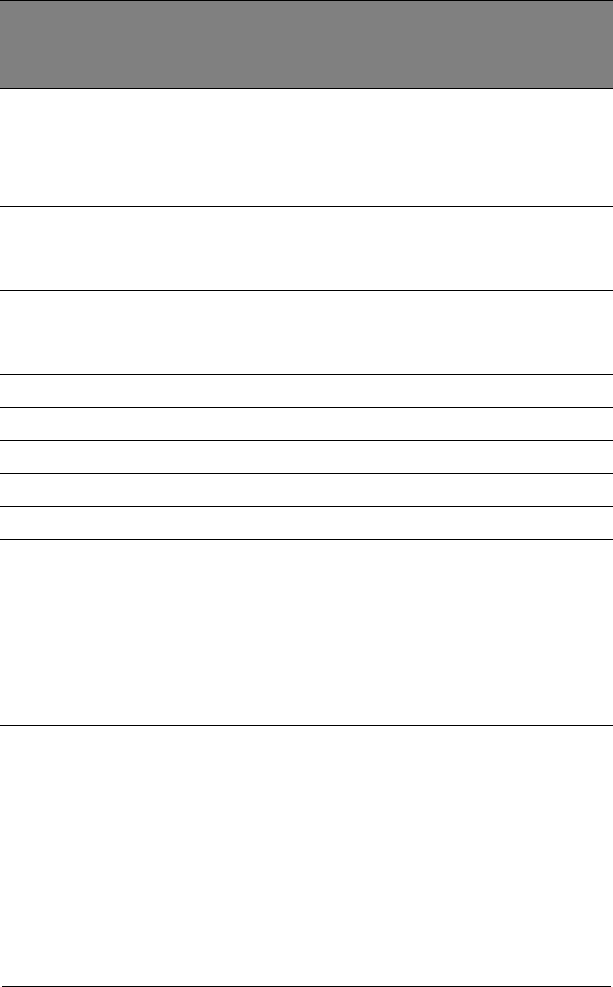
6
Recommended Separation Distances
Recommended Separation Distance Between Portable and Mobile
RF Communications Equipment and the Intraoral Camera System
The Kodak 1500 intraoral camera is intended for use in an electromagnetic
environment in which radiated RF disturbances are controlled. The customer or the
user of the intraoral camera can help prevent electromagnetic interference by
maintaining a minimum distance between portable and mobile RF communication
equipment (transmitters) and the Kodak 1500 intraoral camera as recommended
below, according to the maximum output of the communications equipment.
Rated Maximum
Output Power
of Transmitter
Watts
Separation Distance According to Frequency of Transmitter Meters
150 kHz to 80
MHz
d = 1.17 ÖP
80 MHz to 800
MHz
d = 1.17 ÖP
800 MHz to 2.5 GHz
d = 2.33 ÖP
0.01 0.117 0.117 0.233
0.1 0.37 0.37 0.737
1 1.17 1.17 2.33
10 3.7 3.7 7.36
100 11.7 11.7 23.3
For transmitters rated at a maximum output power not listed above, the
recommended separation distance in meters (m) can be estimated using the
equation applicable to the frequency of the transmitter, where P is the maximum
output power rating of the transmitter in watts (W) according to the transmitter
manufacturer.
Note 1: At 80 MHz and 800 MHz, the separation distance for the higher frequency
range applies.
Note 2: These guidelines may not apply in all situations. Electromagnetic
propagation is affected by absorption and reflection from structures, objects, and
people.

KODAK 1500 Intraoral Camera Safety and Regulatory Guide (8G8224) 7
EMC Standards for Intraoral Camera
IEC 60601-1-2:2001 + A1:2004 EMC requirements and tests, Medical
Electrical Equipment including CISPR11:2003 +A1: 2004 + A2:2006
Group 1, Class B.
NOTE: This equipment has been tested and found to comply with the
limits for a Class A digital device, pursuant to Part 15 of the FCC Rules.
These limits are designed to provide reasonable protection against
harmful interference when the equipment is operated in a commercial
environment. This equipment generates, uses, and can radiate radio
frequency energy and, if not installed and used in accordance with the
instruction manual, may cause harmful interference to radio
communications. Operation of this equipment in a residential area is
likely to cause harmful interference in which case the user will be
required to correct the interference at his own expense.
Install the docking station in such a manner as to maintain a minimum of
20 cm (7.9 inches) separation distance between the radiating element(s)
and all persons. This safety warning conforms to FCC radio frequency
exposure limits.
This device complies with Part 15 of the FCC Rules. Operation is
subject to the following two conditions: (1) this device may not cause
harmful interference, and (2) this device must accept any interference
received, including interference that may cause undesired operation.
Electromagnetic Interference and Electrostatic
Discharge
According to CISPR11:2003 + A1:2004 + A2:2006 Group 1, Class B.
This Class A digital device complies with Canadian ICES-003.
This device has been designed to operate with the antenna listed below,
and having a maximum gain of 1.6 dB. Antennas not included in this list
or having a gain greater than 1.6 dB are strictly prohibited for use with
this device. The required antenna impedance is 50 ohms.

8
Detachable antenna:
Trade Name: Lite
Model Name: CAR-ATR-086-008
Safety Information
The Kodak 1500 intraoral camera is a Type BF device. The
corresponding symbol must be visible on the camera.
Classification in accordance with IEC 60601-1
Conforming Standards- Safety
Canada:
CSA-C22.2 #601.1-M90 (R2005) - Medical Electrical Equipment:
General Requirements for Safety.
China:
GB 9706.1-2007 Medical Electrical Equipment, Part 1: General
Requirements for Safety.
GB_9706.19-2000 Medical Electrical Equipment, Part 2: Particular
requirements for safety -Section 2.18 Specification for endoscopic
equipment. Environmental Requirements and Testing Methods of
Medical Electrical Equipment.
Europe:
EN 60601-1 (1990) + A1: 1993 + A2: 1995 Medical Electrical
Equipment, Part 1: General Requirements for Safety.
Type BF Equipment

KODAK 1500 Intraoral Camera Safety and Regulatory Guide (8G8224) 9
EN 60825-1:2001 Safety of Laser products: Equipment classification,
requirements and User’s Guide
EN 60601-2-18:1997 Medical electrical equipment, Part 2: Particular
requirements for safety -Section 2.18 Specification for endoscopic
equipment.
93/42/EEC MDD (Medical Device Directive)-Europe Only.
ISO13485: 2003 Quality Systems-Medical Devices-Particular
requirements for the application of IS09001.
USA:
UL 60601-1:2003, UL Standard for Safety Medical Electrical
Equipment, Part 1: General Requirements for Safety.
Other Countries:
IEC 60601-1:1988 + A1:1991+A2:1995 Medical electrical equipment;
Part 1: General requirements for safety.
IEC 60601-2-18:1996 Medical Electrical Equipment, Part 2: Particular
requirements for safety -Section 2.18 Specification for endoscopic
equipment.
IEC 60825-1:2001 Safety of Laser products: Equipment classification,
requirements and User's Guide.

10
Communications Equipment
Portable and mobile radio frequency (RF) communications equipment
can affect medical electrical equipment EMC performance.
The wireless version of the Kodak 1500 intraoral camera operates with a
802.11g protocol in a 2.4GHz frequency band. The radio output power
is 20 mW (nominal).
Accessories
The use of cables, adapters, or accessories other than those specified
with the exception of those sold by the manufacturer of the equipment as
replacement parts for internal components, may result in increased
emissions or decreased immunity of the medical equipment.
Changes or modifications not expressly approved by the party responsible
�for compliance could void the user's authority to operate the equipment
Other Equipment
The Kodak 1500 intraoral camera should not be used adjacent to or
stacked with other equipment. If adjacent or stacked use is necessary,
the Kodak 1500 intraoral camera should be observed to verify normal
operation in the configuration in which it will be used.
Condition Classification
Type of protection against electrical shock: Class II Equipment
Degree of protection against electrical shock: Type BF applied part
Degree of protection against ingress of water: Ordinary Protection
Flammable anesthetics:
Not suitable for use in the
presence of flammable
anesthetics or a mixture of
flammable anesthetics with air or
oxygen or nitrous oxide.
Mode of operation Continuous operation
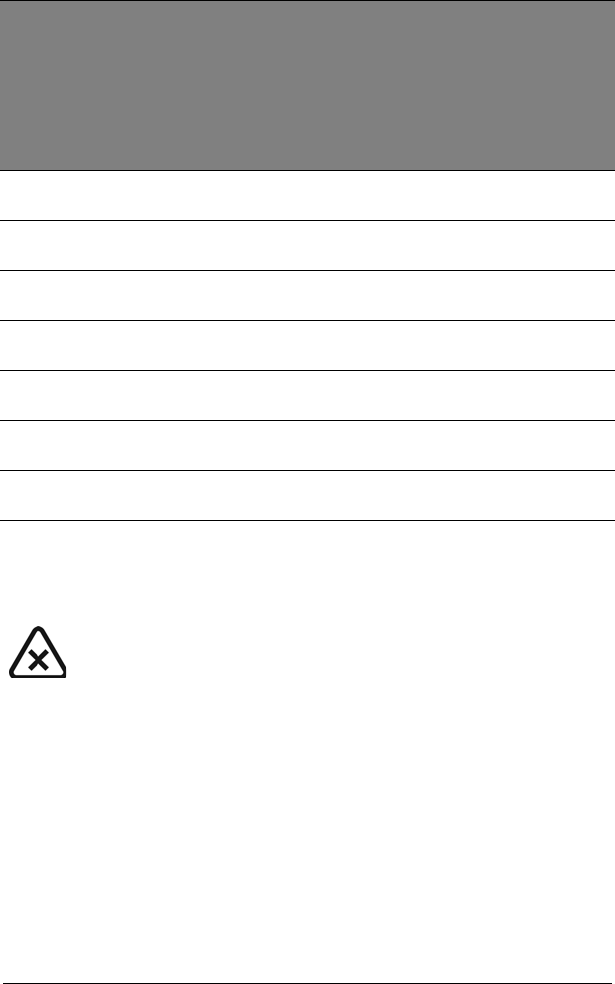
KODAK 1500 Intraoral Camera Safety and Regulatory Guide (8G8224) 11
Cabling
Cautions for Safe Operation
CAUTIONS
•Before using the camera, check the outer surfaces of the
camera and any accessories to ensure there are no rough
surfaces, sharp edges, or protrusions which may cause a
safety hazard.
•Do not pull or twist the cable.
•Do not drop the camera.
•Never place the camera or accessories in a sterilizer or
autoclave.
Interface Max. Cable
Length
Shielded/
Unshielded
Number of
interfaces
with
identical
electrical
character-i
stics
Cable
Classifications
AC Docking
Station - Camera 2.5 m Unshielded 1 AC - DC Adapter
Docking Station -
Camera 2.5 m Shielded 1 Signal, DC Power
(USB)
Docking Station -
Charge Station 2.5 m Unshielded 1 DC Power
Docking Station -
Computer 1.5 m Shielded 1 Signal
Docking Station -
Monitor 1.5 m Shielded 1 Signal
Footpedal -
Docking Station 5.0 m Shielded 1 Signal
Docking Station -
S-Video Monitor 1.5 m Shielded 1 Signal
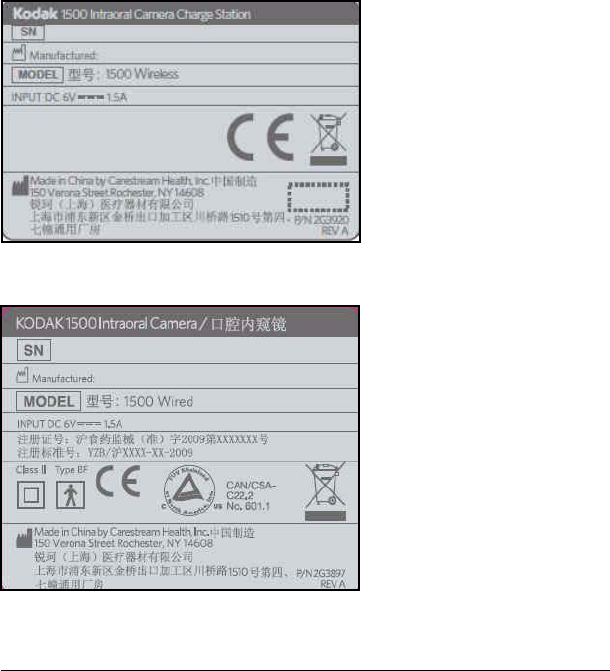
12
•Do not expose the camera to water spray or submerge it in
water.
•Do not expose the camera to high vibrations.
•Do not replace the USB cable that is provided with the
Kodak 1500 intraoral camera with any other USB cable.
•Do not replace the power adaptor that is provided with the
Kodak 1500 intraoral camera with any other power adaptor.
Substitutes may not provide the required electric shock
protection.
Labels
Figure 1 Charge Station
Figure 2 Wired Camera
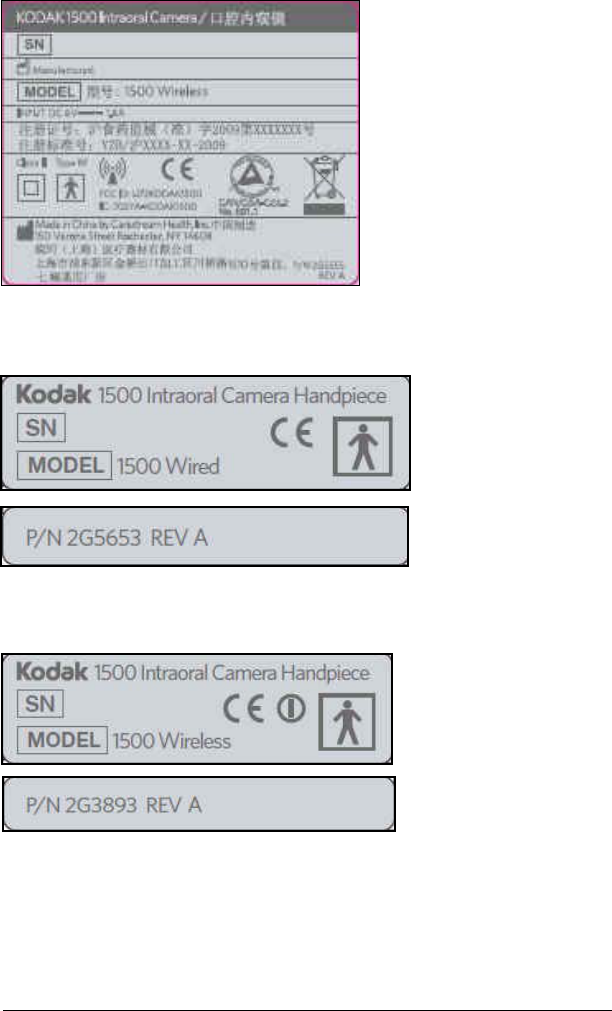
KODAK 1500 Intraoral Camera Safety and Regulatory Guide (8G8224) 13
Figure 3 Wireless Camera
Figure 4 Camera Label Wired
Figure 5 Camera Label Wireless
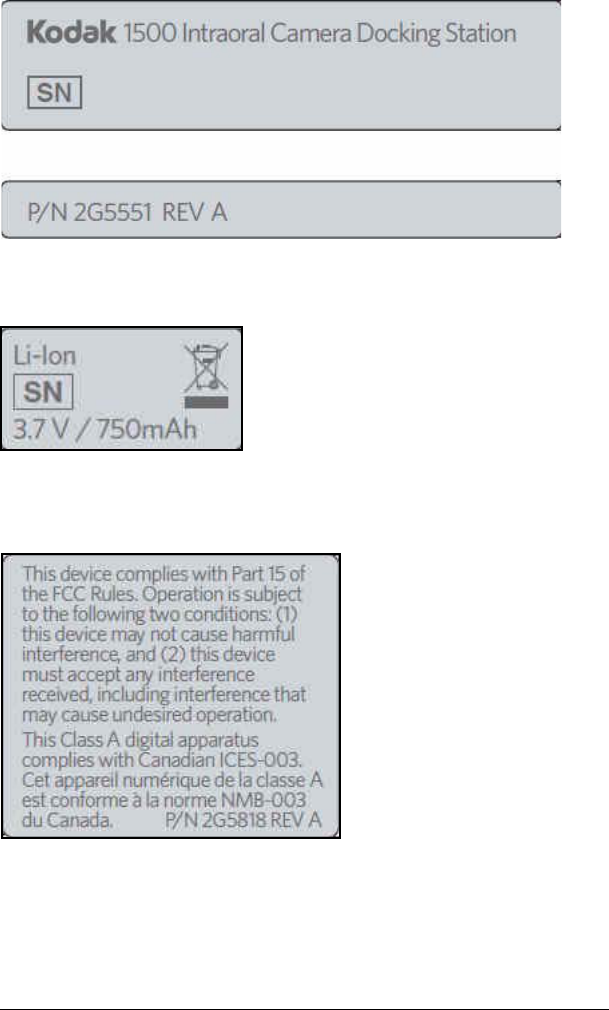
14
Figure 6 Docking Station
Figure 7 Battery
This Class A digital device complies with Canadian ICES-003.
Figure 8 Class A Apparatus

KODAK 1500 Intraoral Camera Safety and Regulatory Guide (8G8224) 15
Figure 9 FCC ID Label
IC: 7027A-KODAK1500

16